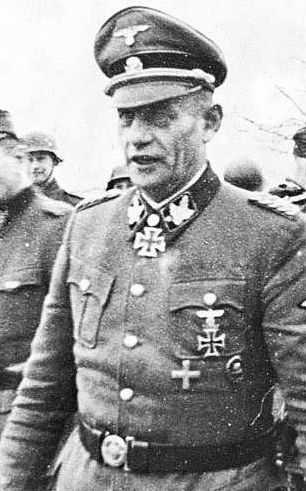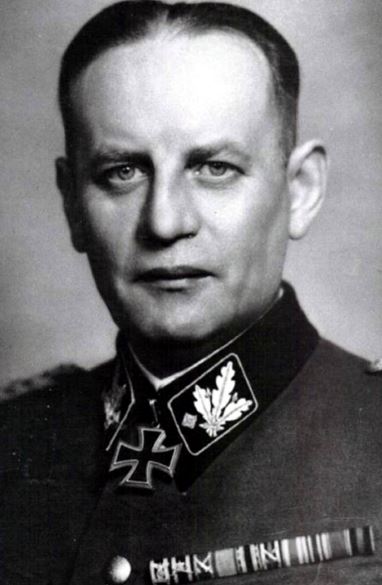Krüger, Walter (Waffen-SS)
- Date of birth:
- February 27th, 1890 (Straßburg/Alsace, Germany)
- Date of death:
- May 22nd, 1945 (Sulęcin, Liepāja, Curland, Lithuania)
- Service number:
- SS-Nr.: 266.184 // NSDAP-Nr.: 3.995.130
- Nationality:
- German
Biography
Elder brother of RKT SS-Obergruppenführer Friedrich-Wilhelm Krüger
Promotions:
01.04.1900: Kadett
00.00.1907: Fähnrich
18.03.1908: Leutnant
25.02.1915: Oberleutnant
18.08.1917: Hauptmann
00.12.1933: SA-Standartenführer
30.04.1935: SS-Obersturmbannführer
30.01.1939: SS-Standartenführer
01.01.1940: SS-Oberführer
20.04.1941: SS-Brigadeführer und Generalmajor der Waffen-SS
30.01.1942: SS-Gruppenführer und Generalleutnant der Waffen-SS
21.06.1944: SS-Obergruppenführer und General der Waffen-SS
Career:
00.00.1900: Kadettenanstalten Karlsruhe und Berlin-Lichterfelde
00.00.1908: Leutnant, 2. badischen Grenadier-Regiment 110
00.08.1914: Bataillon Adjutant
Füsilier-Regiment «Prinz Charles Anton von Hohenzollern» Nr 40
Preussische Jäger-Regiment 2
00.00.1918: Hauptmann und Bataillonskommandeur
00.01.1919: Freikorps, Baltikum, Abt Pfeffer, Westfälische Freikorps, Kurland
00.00.1920-.00.12.1920: MG Kompanie, Schützen-Regiment Nr. 13
00.00.1921: joined the Stahlhelm
00.12.1933: joined the SA
00.00.1935: entered the SS-Verfügungstruppe as SS-Obersturmbannführer, Führer, II. Bataillon, SS-Standarte "Germania"
01.05.1937: entered the NSDAP
00.05.1937: Kdr, II./ SS Standarte 2
00.05.1937-00.10.1937: Lehrer, SS-Junkerschule Bad Tölz
00.10.1937: Offizier, Stab, SS-Standarte 'Deutschland'
00.11.1937: Kdr, IV./ SS-Standarte 'Deutschland'
00.11.1938: Kdr, SS Standarte z.b.V., Ellwangen
00.08.1939: SS-Standartenführer, Ia, SS-Polizei-Division, Western campaign
00.08.1940-00.09.1940: Lehrer, SS-Junkerschule Bad Tölz
00.10.1940: SS-Führungshauptamt in Berlin
25.05.1941-25.06.1941: SS-Brigadeführer, Führer, 1. SS-Brigade (mot)
10.08.1941-15.12.1941: SS-Brigadeführer, Kommandeur, SS-Polizei-Division, Leningrad
16.12.1941: Inspekteur der Infanterie, SS-Führungshauptamt
00.02.1942: Kdr, Amtsgruppe C, SS-FHA
03.04.1943: SS-Gruppenführer, Kommandeur, SS-Panzergrenadier-Division "Das Reich", Bjelgorod
00.12.1943: SS-Gruppenführer, Kommandierender General, IV. SS-Panzerkorps
15.03.1944-24.07.1944: SS-Gruppenführer, Befehlshaber der Waffen-SS, Kommissariat "Ostland"
25.07.1944: SS-Obergruppenführer, Kommandierender General, VI. Waffen-Armeekorps der SS, Nordabschnitt
22.05.1945: suprised by soviet troops in a forest, committed suicide
Do you have more information about this person? Inform us!
- Period:
- First World War (1914-1918)
- Awarded on:
- September 28th, 1914
- Period:
- First World War (1914-1918)
- Awarded on:
- March 12th, 1915
- Period:
- First World War (1914-1918)
- Period:
- First World War (1914-1918)
- Awarded on:
- December 23rd, 1916
- Period:
- First World War (1914-1918)
- Period:
- First World War (1914-1918)
- Awarded on:
- June 24th, 1918
- Period:
- First World War (1914-1918)
- Period:
- First World War (1914-1918)
- Awarded on:
- 1918
- Period:
- First World War (1914-1918)
- Awarded on:
- 1918
- Period:
- First World War (1914-1918)
- Awarded on:
- 1934
- Period:
- Second World War (1939-1945)
- Rank:
- SS-Oberführer (Brigade General)
- Awarded on:
- June 13th, 1940
- Period:
- Second World War (1939-1945)
- Rank:
- SS-Oberführer (Brigade General)
- Awarded on:
- June 22nd, 1940
- Period:
- Second World War (1939-1945)
- Rank:
- SS-Brigadeführer / Generalmajor der Waffen-SS (Brigadier)
- Unit:
- Kommandeur, SS-Polizei-Division, L. Armee-Korps, 18. Armee, Heeresgruppe Nord
- Awarded on:
- December 13th, 1941
734th Award.
- Period:
- Second World War (1939-1945)
- Awarded on:
- 1942
- Period:
- Second World War (1939-1945)
- Rank:
- SS-Gruppenführer / Generalleutnant der Waffen-SS (Lieutenant General)
- Awarded on:
- April 30th, 1943
- Period:
- Second World War (1939-1945)
- Period:
- Second World War (1939-1945)
- Rank:
- SS-Gruppenführer / Generalleutnant der Waffen-SS (Lieutenant General)
- Unit:
- Kommandeur, SS-Panzergrenadier-Division „Das Reich“, II. SS-Panzer-Korps
- Awarded on:
- August 31st, 1943
“SS-Gruppenführer Krüger has led the SS-Pz.Gren.Div. ‘Das Reich’ since the 12.04.1943. In December 1941 he was awarded the Knight’s Cross before Leningrad as the commander of the SS-Pol.Div. During the German offensive operation ‘Citadel’, which took place near Belgorod in the time period 05.-16.07.1943, the SS-Pz.Gren.Div. ‘Das Reich’ had the mission of breaking through the heavily fortified 1st and 2nd Soviet defensive lines between Belgorod and Tomarowka while advancing on the right wing of the SS-Pz.Gren.Div. ‘LSSAH’. It would then press on to Prokhorovka.
Particularly bad weather conditions in the days before the assault muddied up the advance routes, and strong Russian forest defenses hindered the carrying out of the mission. However through the scrupulously conducted preparations (in the form of planning exercises) by Gruppenführer Krüger, as well as his energetic leadership after the start of the assault, it was possible to break through the first line on the first day of the attack. The second Soviet line fell on the following day, an event which enabled the Division to launch a swift thrust to the north.
After the Division had already pressed on further to the north and captured the villages of Lutschki and Kalinin, a crisis suddenly emerged in the deep, open right flank of the Division. This was overcome with swift retaliatory action, thanks to the pronounced calm and determination of the divisional commander. The incessant waves of attacking Soviet tank masses were smashed, and following the employment of the last reserves a viable defense was built up. The destruction of 212 tanks was the success of the day. By rerouting the Panzer-Regiment in these critical hours the Division succeeded in thrusting into the flank and rear of the enemy, and through this Gruppenführer Krüger was able to turn a crisis into a total victory. This was recognized with a special order of the day by the supreme commander of the 4. Panzerarmee.
In the continued fighting on the 14.-15.07.1943, following additional defensive successes to the north, the Division succeeded in launching a surprise attack towards the east against Praworot. Despite difficult road conditions it was able to establish contact with the 7. Panzer-Division, which was coming up from the south further to the east. With this the encirclement of enemy forces in the right flank of the Korps was pulled off. SS-Gruppenführer Krüger had a major share in the success of this attack through his personal influence on the conduct of combat.
After the Division had been pulled out and sent to the Mius front, Gruppenführer Krüger received a new mission. With his Division on the right wing of the Korps, he was to clean up the enemy penetration position along the Mius and reach the river itself. Despite bad weather and road conditions, strong enemy hilltop positions and a fierce defense, Gruppenführer Krüger again succeeded in breaking through the strong enemy field positions with his Division.
Through the capture of the grimly defended strongpoint of Stepanowka, and the pursuit after the fleeing enemy by the SS-Pz.Gren.Div. ‘Das Reich’ (both on the 02.08.1943), the Korps was able to push the Soviets back across the Mius and retake the old German defensive line. SS-Gruppenführer Krüger once more had a decisive share in these successes (which led to the destruction of 26 tanks and the capture of 1400 prisoners) by his personal actions and their influence on the fighting.”
286th Award.
- Period:
- Second World War (1939-1945)
- Period:
- Second World War (1939-1945)
- Period:
- Second World War (1939-1945)
- Rank:
- SS-Obergruppenführer / General der Waffen-SS (General)
- Unit:
- Kommandierender General, VI. SS-Freiwilligen-Armee-Korps
- Awarded on:
- January 11th, 1945
“Subject: Additional leadership deeds of Oakleaves holder SS-Obergruppenführer und General der Waffen-SS Krüger, commanding general of the VI. SS-Korps.
On the 3rd day of the Third Battle of Courland, following an overwhelming artillery barrage, the Russians launched a surprise attack against the front of Gruppe Henze, which was defended by security units and Latvian troops. Already by the midday hours the Russian 19th Tank Corps had succeeded in breaking through the main line and penetrating as far as the artillery positions. SS-Obergruppenführer Krüger dispatched the handful of available Korps reserves to help the Batterien, which were engaged in close combat.
Even so, by the evening of the 23.12.1944 the Russians had succeeded in tearing open a hole at the boundary between Gruppe Henze and the 19th Latvian SS-Division. Their aim was to expand their breakthrough in a northwesterly direction and thereby collapse the northern wing of the 16. Armee. In this dark hour General Krüger ruthlessly weakened his own right wing and threw the units of the 93. Infanterie-Division freed up by this action (namely Grenadier-Regiment 174) against the enemy. However this did not succeed in closing the frontline gap. Thus, despite the impending danger to the left wing of his Korps, General Krüger decided to take the Armee level reserves previously employed in the area of the 19. Latvian SS-Division and use them for a counterattack into the deep right flank of the Russian assault wedge.
Success: The friendly elements that were encircled in Trenci were relieved, and the enemy called off further advances against our left wing during the night. Thus in the following days they commenced a major attack against the entire centre of the Korps’ frontage with strong tank forces (including elements of an additional Tank Corps), and in doing so they broke through the left wing of the 19. Latvian Division and carried on their advance towards Lestene through forest and swamp. Only minor elements of the 227. Division held their ground in the break-in area as an island of resistance. The danger of an operational breakthrough was still present, as our troops had become exhausted following days of fighting and were visibly decreasing in their defensive capabilities. In this situation the leadership would have to show iron resolve.
General Krüger steadfastly stood by his decision to use his last available reserve, a Kampfgruppe of the 4. Pz.Div., to attack in this great defensive battle despite all the other crises that were going on. This decision, maintained only with great difficulty, turned the tide of the battle. The enemy was hit hard in his area of main effort and pushed back. Through the infliction of high losses in the process (including well over 100 tanks) they were forced to suspend their attack.
On the night of the 27./28.12.1944, a firmly constructed defensive line was finally established, and it defied the last attacks of the 11 day Third Battle of Courland. After multiple major crises, a great defensive success was ultimately achieved. General der Waffen-SS Krüger showed outstanding merit in this battle through his firm leadership and unwavering toughness.
I ask that this outstanding performance as a leader be recognized accordingly.”
120th Award.
- Period:
- Second World War (1939-1945)
- Period:
- Second World War (1939-1945)
- Awarded on:
- 1945
Sources
- Photo 1: Public Domain
- Photo 2:
- Photo: Public Domain
- http://www.ritterkreuztraeger.info/rksc/k/SC120Kr�ger.pdf
- - MOONEY, PETER, Waffen-SS Knights and their Battles, Schiffer Pub Ltd, 2008.
- MOONEY, PETER, Waffen-SS Knights and their Battles, Schiffer Publishing, Ltd., 2012.
- Fellgiebel W.P., Elite of the Third Reich, The recipients of the Knight's Cross of the Iron Cross 1939-1945: A Reference, Helion & Company Limited, Solihull, 2003, ISBN 1-874622-46-9
- Yerger M.C., German Cross in Gold, Holders of the SS and Police, Volume 1, "Das Reich" Kurt Amlacher to Heinz Lorenz, R. James Bender Publishing, San Jose, USA, ISBN 0-912138-94-7
- Kwasny A., Kwasny G., Die Eichenlaubträger 1940-1945 (CD), Deutsches Wehrkundearchiv, Lage-Waddenhausen, 2001
- Microfilm Publication A3343. US National Archives.

































